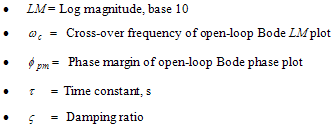
A compensator is an additional component that is incorporated into a system to equalize or compensate for performance insufficiency. There are several basic compensators used in many classical SISO control applications. Most of these compensators are normally placed in series with the system to be compensated with feedback applied around the combination. This configuration is often called cascade compensation and is illustrated below:

The system to be compensated is defined as GH(s) and the compensator as C(s). Negative feedback is applied around the series combination. The signal R is a reference signal, and the signal Y is the output signal.
The basic types of compensators designed here are:
•Gain or Proportional (P)
•Proportional - Derivative (PD)
•Lead
•Proportional - Integral (PI)
•Lag
In designing each compensator, the following system characteristics hold true:
•LM = Log magnitude, base 10
• Cross-over frequency of open-loop Bode
LM plot
Cross-over frequency of open-loop Bode
LM plot
• Phase margin of open-loop Bode
phase plot
Phase margin of open-loop Bode
phase plot
• Time constant, s
Time constant, s
• Damping ratio
Damping ratio

The open-loop Bode frequency response can be used to approximate closed-loop system behavior, provided the open-loop frequency response satisfies three conditions:
•The gain at low frequencies is relatively high for low steady-state errors
•The gain at high frequencies is relatively low for disturbance attenuation
•The slope of the Bode plot is approximately

When the above conditions are approximately satisfied, the following correlations are valid:

